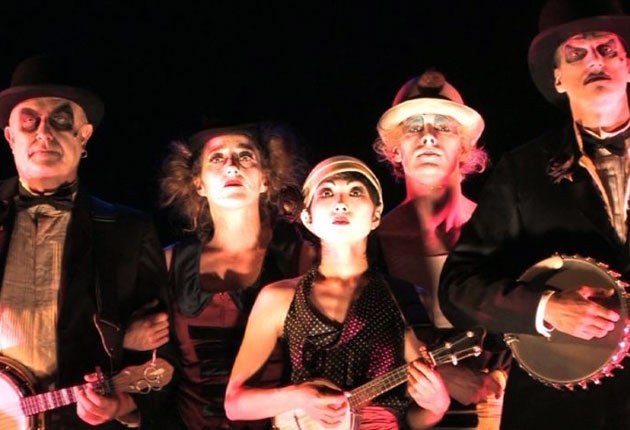Dancing On Your Grave, Riverside Studios, London
Grisly show is dead funny

Your support helps us to tell the story
From reproductive rights to climate change to Big Tech, The Independent is on the ground when the story is developing. Whether it's investigating the financials of Elon Musk's pro-Trump PAC or producing our latest documentary, 'The A Word', which shines a light on the American women fighting for reproductive rights, we know how important it is to parse out the facts from the messaging.
At such a critical moment in US history, we need reporters on the ground. Your donation allows us to keep sending journalists to speak to both sides of the story.
The Independent is trusted by Americans across the entire political spectrum. And unlike many other quality news outlets, we choose not to lock Americans out of our reporting and analysis with paywalls. We believe quality journalism should be available to everyone, paid for by those who can afford it.
Your support makes all the difference.‘You’re a short time living,” say the performers, eyeing the audience with resentful glee, “and a long, long, long, long, long time dead.” They should know: Lea Anderson’s show has a cast of music-hall corpses. Even death can’t keep them from their leering songs and once-perky chorus numbers.
The music, written and performed by Steve Blake and Nigel Burch, is full of bouncy banjo tunes and gruesomely witty lyrics. Rhymes and rhythms are tight, the whole show jangling along with manic, pessimistic energy. “I’m dead from the neck up,” Burch complains. “From the neck down, too,” agrees Blake.
The show itself is directed and choreographed by Anderson, who recently celebrated 25 years of work with her all-female Cholmondeley and all-male Featherstonehaugh troupes. Dancing on your Grave plays to her strengths: the precise sense of gesture, the quirkiness, the downright way of creating a theatrical world.
She crams her performers on to a tiny stage within a stage – three metres square at most, with all five performers (three dancers, two musicians) always on it. They’re stuck in a performers’ purgatory, never able to leave the stage.
The designer, Jess Hooks, dresses them as 1930s vaudeville zombies, with touches of thrift-shop glamour. Blake and Burch wear whiteface makeup, with blackened lips and eye sockets. Dancer Ryen Perkins-Gangnes is a bedraggled Pierrot. Valentina Formenti has a daft little hat and swags of lace on her skirts, while Maho Ihara is a chorus girl in French knickers and strappy shoes.
Ihara has the funniest dance number, a wonderful series of suicide mimes. She carefully tries cutting her own throat, shooting, stabbing, gas ovens and hanging, every method exactly carried out. Her fingers flutter delicately, to show splattering blood or spilling intestines. None of it works: she keeps picking herself up, ready for another go. Best of all are her jumps from a series of ever higher buildings. It’s exactly the same mime, with the “falling” pose lasting longer each time.
The dancers act as a chorus for some songs, wearily playing percussion, adding jazz-hands poses or joining in the refrains. Ihara and Perkins-Gangnes shuffle through a 1930s number, with syncopated steps and outstretched zombie arms. Formenti prowls alone behind her colleagues, back in the land of the living, as Burch’s undead musician sings about the wife who survived him. It doesn’t matter, they agree; everybody’s single when they’re dead.
Several numbers urge the audience to make the most of living – what there is of it. Others object to the dreariness of bodiless existence. The whole show is a brilliant mixture of grisliness and vigour. It skips and shuffles along, never more lively than when complaining about death.
To 22 February (020-8237 1111)
Join our commenting forum
Join thought-provoking conversations, follow other Independent readers and see their replies
Comments